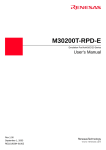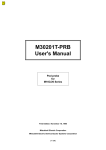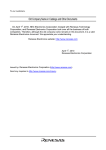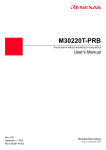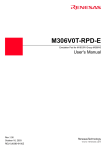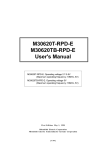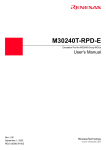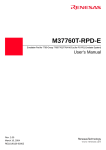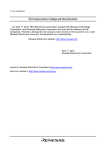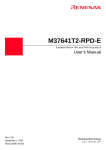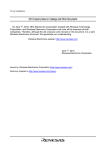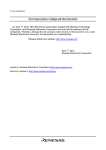Download Renesas Emulation Pod forM16C/20 Series M30200T-RPD-E Technical information
Transcript
To our customers, Old Company Name in Catalogs and Other Documents On April 1st, 2010, NEC Electronics Corporation merged with Renesas Technology Corporation, and Renesas Electronics Corporation took over all the business of both companies. Therefore, although the old company name remains in this document, it is a valid Renesas Electronics document. We appreciate your understanding. Renesas Electronics website: http://www.renesas.com April 1st, 2010 Renesas Electronics Corporation Issued by: Renesas Electronics Corporation (http://www.renesas.com) Send any inquiries to http://www.renesas.com/inquiry. Notice 1. 2. 3. 4. 5. 6. 7. All information included in this document is current as of the date this document is issued. Such information, however, is subject to change without any prior notice. Before purchasing or using any Renesas Electronics products listed herein, please confirm the latest product information with a Renesas Electronics sales office. Also, please pay regular and careful attention to additional and different information to be disclosed by Renesas Electronics such as that disclosed through our website. Renesas Electronics does not assume any liability for infringement of patents, copyrights, or other intellectual property rights of third parties by or arising from the use of Renesas Electronics products or technical information described in this document. No license, express, implied or otherwise, is granted hereby under any patents, copyrights or other intellectual property rights of Renesas Electronics or others. You should not alter, modify, copy, or otherwise misappropriate any Renesas Electronics product, whether in whole or in part. Descriptions of circuits, software and other related information in this document are provided only to illustrate the operation of semiconductor products and application examples. You are fully responsible for the incorporation of these circuits, software, and information in the design of your equipment. Renesas Electronics assumes no responsibility for any losses incurred by you or third parties arising from the use of these circuits, software, or information. When exporting the products or technology described in this document, you should comply with the applicable export control laws and regulations and follow the procedures required by such laws and regulations. You should not use Renesas Electronics products or the technology described in this document for any purpose relating to military applications or use by the military, including but not limited to the development of weapons of mass destruction. Renesas Electronics products and technology may not be used for or incorporated into any products or systems whose manufacture, use, or sale is prohibited under any applicable domestic or foreign laws or regulations. Renesas Electronics has used reasonable care in preparing the information included in this document, but Renesas Electronics does not warrant that such information is error free. Renesas Electronics assumes no liability whatsoever for any damages incurred by you resulting from errors in or omissions from the information included herein. Renesas Electronics products are classified according to the following three quality grades: “Standard”, “High Quality”, and “Specific”. The recommended applications for each Renesas Electronics product depends on the product’s quality grade, as indicated below. You must check the quality grade of each Renesas Electronics product before using it in a particular application. You may not use any Renesas Electronics product for any application categorized as “Specific” without the prior written consent of Renesas Electronics. Further, you may not use any Renesas Electronics product for any application for which it is not intended without the prior written consent of Renesas Electronics. Renesas Electronics shall not be in any way liable for any damages or losses incurred by you or third parties arising from the use of any Renesas Electronics product for an application categorized as “Specific” or for which the product is not intended where you have failed to obtain the prior written consent of Renesas Electronics. The quality grade of each Renesas Electronics product is “Standard” unless otherwise expressly specified in a Renesas Electronics data sheets or data books, etc. “Standard”: 8. 9. 10. 11. 12. Computers; office equipment; communications equipment; test and measurement equipment; audio and visual equipment; home electronic appliances; machine tools; personal electronic equipment; and industrial robots. “High Quality”: Transportation equipment (automobiles, trains, ships, etc.); traffic control systems; anti-disaster systems; anticrime systems; safety equipment; and medical equipment not specifically designed for life support. “Specific”: Aircraft; aerospace equipment; submersible repeaters; nuclear reactor control systems; medical equipment or systems for life support (e.g. artificial life support devices or systems), surgical implantations, or healthcare intervention (e.g. excision, etc.), and any other applications or purposes that pose a direct threat to human life. You should use the Renesas Electronics products described in this document within the range specified by Renesas Electronics, especially with respect to the maximum rating, operating supply voltage range, movement power voltage range, heat radiation characteristics, installation and other product characteristics. Renesas Electronics shall have no liability for malfunctions or damages arising out of the use of Renesas Electronics products beyond such specified ranges. Although Renesas Electronics endeavors to improve the quality and reliability of its products, semiconductor products have specific characteristics such as the occurrence of failure at a certain rate and malfunctions under certain use conditions. Further, Renesas Electronics products are not subject to radiation resistance design. Please be sure to implement safety measures to guard them against the possibility of physical injury, and injury or damage caused by fire in the event of the failure of a Renesas Electronics product, such as safety design for hardware and software including but not limited to redundancy, fire control and malfunction prevention, appropriate treatment for aging degradation or any other appropriate measures. Because the evaluation of microcomputer software alone is very difficult, please evaluate the safety of the final products or system manufactured by you. Please contact a Renesas Electronics sales office for details as to environmental matters such as the environmental compatibility of each Renesas Electronics product. Please use Renesas Electronics products in compliance with all applicable laws and regulations that regulate the inclusion or use of controlled substances, including without limitation, the EU RoHS Directive. Renesas Electronics assumes no liability for damages or losses occurring as a result of your noncompliance with applicable laws and regulations. This document may not be reproduced or duplicated, in any form, in whole or in part, without prior written consent of Renesas Electronics. Please contact a Renesas Electronics sales office if you have any questions regarding the information contained in this document or Renesas Electronics products, or if you have any other inquiries. (Note 1) “Renesas Electronics” as used in this document means Renesas Electronics Corporation and also includes its majorityowned subsidiaries. (Note 2) “Renesas Electronics product(s)” means any product developed or manufactured by or for Renesas Electronics. User’s Manual M30200T-RPD-E User’s Manual Emulation Pod forM16C/20 Series Rev.1.00 2003.09 Keep safety first in your circuit designs! • Renesas Technology Corporation and Renesas Solutions Corporation put the maximum effort into making semiconductor products better and more reliable, but there is always the possibility that trouble may occur with them. Trouble with semiconductors may lead to personal injury, fire or property damage. Remember to give due consideration to safety when making your circuit designs, with appropriate measures such as (i) placement of substitutive, auxiliary circuits, (ii) use of nonflammable material or (iii) prevention against any malfunction or mishap. Notes regarding these materials • These materials are intended as a reference to assist our customers in the selection of the Renesas Technology product best suited to the customer's application; they do not convey any license under any intellectual property rights, or any other rights, belonging to Renesas Technology Corporation, Renesas Solutions Corporation or a third party. • Renesas Technology Corporation and Renesas Solutions Corporation assume no responsibility for any damage, or infringement of any third-party's rights, originating in the use of any product data, diagrams, charts, programs, algorithms, or circuit application examples contained in these materials. • All information contained in these materials, including product data, diagrams, charts, programs and algorithms represents information on products at the time of publication of these materials, and are subject to change by Renesas Technology Corporation and Renesas Solutions Corporation without notice due to product improvements or other reasons. It is therefore recommended that customers contact Renesas Technology Corporation, Renesas Solutions Corporation or an authorized Renesas Technology product distributor for the latest product information before purchasing a product listed herein. The information described here may contain technical inaccuracies or typographical errors. Renesas Technology Corporation and Renesas Solutions Corporation assume no responsibility for any damage, liability, or other loss rising from these inaccuracies or errors. Please also pay attention to information published by Renesas Technology Corporation and Renesas Solutions Corporation by various means, including the Renesas home page (http://www.renesas.com). • When using any or all of the information contained in these materials, including product data, diagrams, charts, programs, and algorithms, please be sure to evaluate all information as a total system before making a final decision on the applicability of the information and products. Renesas Technology Corporation and Renesas Solutions Corporation assume no responsibility for any damage, liability or other loss resulting from the information contained herein. • Renesas Technology semiconductors are not designed or manufactured for use in a device or system that is used under circumstances in which human life is potentially at stake. Please contact Renesas Technology Corporation, Renesas Solutions Corporation or an authorized Renesas Technology product distributor when considering the use of a product contained herein for any specific purposes, such as apparatus or systems for transportation, vehicular, medical, aerospace, nuclear, or undersea repeater use. • The prior written approval of Renesas Technology Corporation and Renesas Solutions Corporation is necessary to reprint or reproduce in whole or in part these materials. • If these products or technologies are subject to the Japanese export control restrictions, they must be exported under a license from the Japanese government and cannot be imported into a country other than the approved destination. Any diversion or reexport contrary to the export control laws and regulations of Japan and/or the country of destination is prohibited. • Please contact Renesas Technology Corporation or Renesas Solutions Corporation for further details on these materials or the products contained therein. Precautions to be taken when using this product • This product is a development supporting unit for use in your program development and evaluation stages. In mass-producing your program you have finished developing, be sure to make a judgment on your own risk that it can be put to practical use by performing integration test, evaluation, or some experiment else. • In no event shall Renesas Solutions Corporation be liable for any consequence arising from the use of this product. • Renesas Solutions Corporation strives to renovate or provide a workaround for product malfunction at some charge or without charge. However, this does not necessarily mean that Renesas Solutions Corporation guarantees the renovation or the provision under any circumstances. • This product has been developed by assuming its use for program development and evaluation in laboratories. Therefore, it does not fall under the application of Electrical Appliance and Material Safety Law and protection against electromagnetic interference when used in Japan. • Do not attempt to modify this equipment. If modified, your authority to operate this equipment might be voided by FCC. Note: This equipment has been tested and found to comply with the limits for a Class A digital device, pursuant to part 15 of the FCC Rules. These limits are designed to provide reasonable protection against harmful interference when the equipment is operated in a commercial environment. This equipment generates, uses, and can radiate radio frequency energy and, if not installed and used in accordance with the instruction manual, may cause harmful interference to radio communications. Operation of this equipment in a residential area is likely to cause harmful interference in which case the user will be required to correct the interference at his own expense. Warning: This is a Class A product. In a domestic environment this product may cause radio interference in which case the user may be required to take adequate measures. For inquiries about the contents of this document or product, fill in the text file the installer of the emulator debugger generates in the following directory and email to your local distributor. \SUPPORT\Product-name\SUPPORT.TXT Renesas Tools Homepage http://www.renesas.com/en/tools ( 2 / 32 ) Preface The M30200T-RPD-E is an emulation pod main unit for M16C/20 Series of Renesas 16-bit microcomputers. The M30200T-RPD-E is used by connecting to the pod probe M302xxT-PRB and the PC4701 emulator main unit, and is controlled by the emulator debugger. This manual mainly explains specifications and setting up of the M30200T-RPD-E. For detail information about the pod probe, the PC4701 emulator main unit and the emulator debugger, refer to each user's manual. To check the components of this product, refer to "Things to Check When Unpacking" in this manual. If there is any question or doubt about this product, contact your local distributor. To use the product properly Precautions for Safety: • Both in this User's Manual and on the product itself, several icons are used to insure proper handling of this product and also to prevent injuries to you or other persons, or damage to your properties. • The icons' graphic images and meanings are given in Chapter 1 Precautions for Safety. Be sure to read this chapter before using the product. ( 3 / 32 ) Contents Summary ................................................................................................................................. 6 Terminology ........................................................................................................................... 7 Things to Check When Unpacking ......................................................................................... 8 Chapter 1. Precautions for Safety ........................................................................................... 9 1.1 Safety Symbols and Meanings .............................................................................. 9 WARNING Warning for Installation ................................................................................. 10 Warning for Use Environment ....................................................................... 10 CAUTION Caution to be Taken for Modifying This Product .......................................... 10 Cautions to be Taken for This Product .......................................................... 10 IMPORTANT Notes on PC4701 Emulator Main Units ........................................................ 11 Note on Abnormal Operation of PC4701 System ......................................... 11 Notes on the Target System ........................................................................... 11 Notes on Connecting Pod Probe and Pitch Converter Board ........................ 12 Note on Starting Up the Emulator System ..................................................... 12 Note on Reset Input from the Target System ................................................ 12 Note on Address 0 Access ............................................................................. 13 Note on Differences between Actual MCU and Emulator ............................ 13 Note on Referencing and Setting the Work Area .......................................... 13 Notes on MAP References and Settings ........................................................ 13 Note on Changing Settings of the Memory Area .......................................... 13 Note on Stack ................................................................................................. 14 Note on BRK Instruction ............................................................................... 14 Note on Software Break and Hardware Break ............................................... 14 Notes on Using Address-match Interrupts ..................................................... 14 Note on Software Reset ................................................................................. 14 Note on Stop and Wait Modes ....................................................................... 14 Note on Watchdog Function .......................................................................... 14 Chapter 2. Introduction ......................................................................................................... 15 Chapter 3. Specifications ...................................................................................................... 16 Chapter 4. Setting Up ........................................................................................................... 17 4.1 Removing the Upper Cover ................................................................................ 17 4.2 Setting Oscillation Frequency ............................................................................. 18 Chapter 5. Connection .......................................................................................................... 22 5.1 Connection to the Emulator Main Unit ............................................................... 22 5.2 Connection to the Emulation Pod ....................................................................... 23 5.3 Connection to the Pod Probe ............................................................................... 24 ( 4 / 32 ) Chapter 6. External Dimensions ........................................................................................... 25 Chapter 7. Maintenance and Warranty ................................................................................. 27 7.1 Maintenance ........................................................................................................ 27 7.2 Warranty .............................................................................................................. 27 7.3 Repair Provisions ................................................................................................ 27 7.4 How to Request for Repair .................................................................................. 28 Chapter 8. Troubleshooting .................................................................................................. 29 ( 5 / 32 ) Summary Chapter 1. Precautions for Safety This chapter describes the precautions which should be taken in order to use M30200T-RPD-E safely and properly. Refer to each manual of the pod probe, the emulator main unit and the emulator debugger for their precautions. Chapter 2. Introduction This chapter provides the system configuration and overview of M30200T-RPD-E. Chapter 3. Specifications This chapter lists the product specifications of M30200T-RPD-E. Chapter 4. Setting Up This chapter describes how to set up the M30200T-RPD-E hardware according to your system. Chapter 5. Connection This chapter describes how to connect the M30200T-RPD-E, emulator main unit and pod probe. For connection between the host machine and emulator main unit, connection between the pod probe and the target system, and installation of the emulator debugger, refer to each user's manual of the products. Chapter 6. External Dimensions This chapter shows the external dimensions of M30200T-RPD-E and its probe. Chapter 7. Maintenance and Warranty This chapter describes maintenance and warranty of M30200T-RPD-E. Chapter 8. Troubleshooting This chapter describes what to do when the emulation pod main unit does not work properly. ( 6 / 32 ) Terminology Some specific words used in this User's Manual are defined as follows: Emulator system This means an emulator system built around a PC4701 emulator. The PC4701 emulator system is configured with the emulator main unit, emulation pod main unit, pod probe, host machine, and emulator debugger. Emulator main unit PC4701 This means a generic name for emulators for 8 and 16-bit MCUs. For details on specific models of PC4701, visit Renesas Tools Homepage at http://www.renesas.com/en/tools Emulation pod main unit This means M30200T-RPD-E (this product). This emulation pod main unit is for M16C/20 series MCUs. Pod probe This means a pod probe equipped with an MCU for each group of M16C/20 Series. Host machine This means a personal computer used to control the emulator and emulation pod. Emulator debugger This means the following software tool to control the emulator from the host machine through an interface (serial, parallel, LPT parallel or LAN). Emulator debugger M3T-PD30 V.4.00 or later Firmware This means a program that analyzes contents of communication with the emulator debugger and controls the emulator hardware. The emulator contains an EEPROM. You can download from the emulator debugger when upgrading the version of the firmware itself or when handling another MCU. Target MCU This means the microcomputer you are going to debug. Target system This means a user's application system using the microcomputer to be debugged. ( 7 / 32 ) Things to Check When Unpacking The M30200T-RPD-E consists of the following parts and manuals. When unpacking, check to see if your M30200T-RPD-E package contains all of these items. Type name Description Quantity M30200T-RPD-E Emulation pod main unit 1 FLX120-RPD Flexible cable for connecting PC4701 emulator 1 FLX64-PRB Pitch converter board for connecting the pod probe (pre-installed) 1 OSC-3 (10 MHz) Oscillator circuit board (pre-installed) 1 OSC-2 (32 MHz) Oscillator circuit board (pre-installed) 1 OSC-2 Oscillator circuit bare board 1 M30200T-RPD-E English user's manual English user's manual (this manual) 1 M30200T-RPD-E Japanese user's manual Japanese user's manual 1 Please keep the M30200T-RPD-E’s packing box and cushion material in your place for reuse at a later time when sending your product for repair or other purposes. Always use these packing box and cushion material when transporting the products. If any of these items are missing or found faulty, please contact your local distributor. Also, if there is any question or doubt about the packaged product, contact your local distributor. Other tool products required for this product: • • • • Emulator main unit: PC4701 (essential) Pod probe with an MCU for M16C/20 Series: M302xxT-PRB (essential) Emulator debugger: M3T-PD30 (essential) PROM programming adapter: PCA7302xxx-xx To purchase the products listed above, contact your local distributor. ( 8 / 32 ) Chapter 1. Precautions for Safety In both the user's manual and on the product itself, several icons are used to insure proper handling of this product and also to prevent injuries to you or other persons, or damage to your properties. This chapter describes the precautions which should be taken in order to use this product safely and properly. Be sure to read this chapter before using this product. 1.1 Safety Symbols and Meanings WARNING If the requirements shown in the "WARNING" sentences are ignored, the equipment may cause serious personal injury or death. CAUTION If the requirements shown in the "CAUTION" sentences are ignored, the equipment may malfunction. IMPORTANT It means important information on using this product. In addition to the three above, the following are also used as appropriate. means WARNING or CAUTION. Example: CAUTION AGAINST AN ELECTRIC SHOCK means PROHIBITION. Example: DISASSEMBLY PROHIBITED means A FORCIBLE ACTION. Example: UNPLUG THE POWER CABLE FROM THE RECEPTACLE. The following pages describe the symbols "WARNING", "CAUTION", and "IMPORTANT". ( 9 / 32 ) WARNING Warning for Installation: • Do not set this product in water or areas of high humidity. Make sure that the emulation pod main unit does not get wet. Spilling water or other liquids into the emulation pod main unit can cause an unrepairable damage. Warning for Use Environment: • The emulation pod main unit is air-cooled with the ventilation slot. Therefore, do not block the ventilation slot. When heated to high temperatures, the emulation pod main unit may not work properly. • This equipment is to be used in an environment with a maximum ambient temperature of 35°C. Care should be taken that this temperature is not exceeded. CAUTION Caution to be Taken for Modifying This Product: • Do not disassemble or modify this product. Disassembling or modifying this product can cause damage. Disassembling and modifying the product will void your warranty. Cautions to be Taken for This Product: • Use caution when handling the emulation pod main unit. Be careful not to apply a mechanical shock. • Do not touch directly the connector pins of the emulator main unit or the target MCU connector pins with your hand. • Do not pull the emulation pod main unit by the FLX120-RPD flexible cable or the FLX64 flexible cable. • The flexible cables FLX120-RPD and FLX64 are different from earlier models. The slits make them more flexible. However, excessive flexing or force may break conductors. • Do not use inch-size screws for this equipment. The screws used in this equipment are all ISO (meter-size) type screws. When replacing screws, use same type screws as used on the equipment. ( 10 / 32 ) IMPORTANT Notes on PC4701 Emulator Main Units: • EMI standards are not met when this product is used with the PC4700H or PC4700L emulator main unit. • The PC4700H emulator main units whose serial number ends with a number cannot be used with M30200T-RPD-E. Use only products whose serial number ends with a letter of the alphabet. The serial number is on the bottom of the PC4700H. Example: 5KE100 .......... Can NOT be used with M30200T-RPD-E. Requires an upgrade. Example: 5LE123B ........ Can be used with M30200T-RPD-E. • Do not turn off the power when downloading firmware. If the emulator is powered off in the middle of the process, it will become unable to start up normally. In cases when the power is inadvertently shut off, re-execute downloading. Note on Abnormal Operation of PC4701 System: • If the PC4701 system does not pass all self-checks (excluding when an target system error occurs), there is the possibility of trouble in the system. In such case, contact the place of purchase. (Selfcheck should be executed when the target system is not connected.) • If the emulator main unit malfunctions due to external interference or some other causes, follow the steps given below. (1) Press the system reset switch located on the front panel of the emulator main unit. (2) If the emulator does not return to the normal operation despite the step (1) above, turn off the power source of the emulator main unit, turn it on again. Notes on the Target System: • Because the emulation pod main unit does not have the capacity to supply power to other devices, design your system so that the emulator MCU is powered by the target system. • Make sure that the target's supply voltage is 2.7 to 5 V. • Before turning on power to anything, check the host machine, emulator main unit, emulation pod main unit, pod probe, converter board and user's target system are properly connected. As explained here following, activate power to units as simultaneously as possible. Reverse the procedure to turn them off. (1) Turn on the target system. (2) Turn on the emulator main unit. ( 11 / 32 ) IMPORTANT Notes on Connecting Pod Probe and Pitch Converter Board: • Prepare the right pod probe for your MCU. Without a pod probe this product cannot be used. • When connecting the pod probe and the pitch converter board, be careful not to forcibly press the connector top of the converter board. (The flexible cable and the converter board are guaranteed for only 20 insertion/removal iterations.) • Especially be careful not to insert the converter board in the wrong direction. Note on Starting Up the Emulator System: • Check the emulator starts up properly from the target status LEDs on the front panel of the emulator main unit itself. When power is received from the target system: ... The POWER target status is ON. When the clock starts oscillating: ........................... The CLOCK target status is ON. When the reset is released: ..................................... The RESET target status is OFF. If the LEDs behave as described above within approximately 5 seconds of turning ON the power, the emulator has started up properly. Notes on Reset Input from the Target System: • The reset input from the target system is accepted only during program execution (while the RUN signal LED on the PC4701 is lit). ( 12 / 32 ) IMPORTANT Note on Address 0 Access: • With the M16C/20 series MCU, when a maskable interrupt is generated, the interrupt data (interrupt No. and interrupt request level) stored in address 0 is read out. Also, the interrupt request bit is cleared when address 0 is read out. Consequently, when the address 0 read-out instruction is executed or when address 0 is read out in the cause of a program runaway, a malfunction occurs in that the interrupt is not executed despite the interrupt request, because the request bit of the highest priority interrupt factor enabled is cleared. Note on Differences between Actual MCU and Emulator: • Emulator operation differs from mask MCU operation, as listed below: (1) Initial values of internal resource data at power-on (2) Internal ROM and RAM capacities, etc. (3) A/D converter A/D converter characteristics differ from actual MCU characteristics because the flexible cable and other elements are used between the emulation MCU and target system. Note on Referencing and Setting the Work Area: • The work area given below is assigned as the initial setting at the time of starting up the emulator debugger. 02C0016 to 02C0F16: Work area Notes on MAP References and Settings: • When starting up M30200T-RPD-E, initial MAP settings are as follows. 0000016 to 003FF16: EXT 0040016 to FFFFF16: INT • Always set the SFR area to EXT (external). Note on Changing Settings of the Memory Area: • To debug an MCU different in memory capacity, be sure to modify the settings in the memory area before using the MCU. For memory maps of respective MCUs, see the MCU User's Manual. ( 13 / 32 ) IMPORTANT Note on Stack: • This product uses up to 8 bytes for stack. Note on BRK Instruction: • BRK instruction cannot be used. Note on Software Break and Hardware Break: • A software break and a hardware break cannot be used simultaneously. If they are used simultaneously, the emulation pod main unit may not work properly. Notes on Using Address-match Interrupts: • Do not set software breaks at the same addresses as address-match interrupts as the program may run out of control. • Do not set a hardware break within 4 instructions before an address at which an address-match interrupt occurs. If you do set a hardware break in this range, the program will run out of control. • When an address at which an address-match interrupt occurs is executed in one-step mode, the program stops after executing the first instruction after returning from the address-match interrupt processing. Note on Software Reset: • Do not use the software reset. It may not work properly. Note on Stop and Wait Modes: • Do not perform step execution at addresses in the stop or wait mode. It may cause communication errors. Note on Watchdog Function: • Debug functions such as a single step cannot be used while using the watchdog function. Only GO command (program execution) is possible. To use other debug functions, disable the watchdog function. ( 14 / 32 ) Chapter 2. Introduction M30200T-RPD-E is used by connecting to the PC4701 emulator main unit. Figure 2.1 shows the system configuration. Figure 2.1 System configuration Products (1) to (4) shown in Figure 2.1 are included with this product. (1) M30200T-RPD-E (Emulation pod main unit) This emulation pod main unit contains emulation memory and debugging functions. (2) FLX120-RPD (Flexible cable) This 120-pin flexible cable connects the PC4701 emulator main unit and emulation pod main unit. (3) FLX64 (Flexible cable) This 64-pin flexible cable connects the emulation pod main unit and pod probe. (4) FLX64-PRB (Pitch converter board) This board connects the 64-pin flexible board and pod probe. ( 15 / 32 ) Chapter 3. Specifications Table 3.1 lists the specifications of M30200T-RPD-E. Table 3.1 Specifications of M30200T-RPD-E Usable emulator main unit PC4701 Usable MCU M16C/20 Series MCUs Usable MCU mode Single-chip mode Emulation memory 1 MB Clock Xin: 10 MHz Xcin: 32.768 kHz Power supply range +2.7 to 5.5 V Stack capacity used for emulator Up to 8 bytes Suspended cycles in run-time debug 16-byte dump: Approx. 312 BCLK cycle 16-byte fill: Approx. 283 BCLK cycle Power supply to emulation pod 1. Supplied from an emulator main unit 2. The operating voltage of the emulation pod main unit is determined by detecting the supply voltage of the target system. When no target system is connected, or when the supply voltage of the target system is more than 5.0 V, the operating voltage is 5.0 V. Operating temperature range 5 to 35°C (no dew) Storage temperature range -10 to 60°C (no dew) Overseas standards (1) U.S. EMI standards (FCC part 15 Class A) (2) CE marking (EN55022, EN50082-1) ( 16 / 32 ) Chapter 4. Setting Up 4.1 Removing the Upper Cover If you need to change the input frequency, remove the upper cover of the product to change the configuration. (1) Remove the four screws of both sides and lift off the upper cover. (see Figure 4.1) (2) Change the input frequency following the instructions shown below. (3) Replace the upper cover and tighten the four screws. Figure 4.1 Removing the upper cover Caution Before Removing the Upper Cover: • Always shut OFF power before removing the cover and changing the oscillator circuit board. Removing the cover and setting switches in the power ON state could destroy internal circuits. ( 17 / 32 ) 4.2 Setting Oscillation Frequency When you are using the emulation pod main unit's internal oscillator, see (1) below, and when you are using the target system's oscillator, see (2) on page 21. (1) Using emulation pod main unit's oscillator M30200T-RPD-E is available with two types of internal oscillator circuits: • OSC-3 oscillator circuit board (default when shipped): Xin = 10 MHz • OSC-2 oscillator circuit board (bare board) a. OSC-3 oscillator circuit board M30200T-RPD-E is equipped with a 10MHz internal oscillator circuit board (OSC-3). If you are running M30200T-RPD-E at 10 MHz, you can use the OSC-3 oscillator circuit board. b. OSC-2 oscillator circuit board M30200T-RPD-E is supplied with the OSC-2 oscillator circuit bare board (connector pin mounted). If you are using M30200T-RPD-E with internal oscillation frequencies other than 10 MHz, create the desired oscillator circuit on the OSC-2 bare board and replace the OSC3 board with the OSC-2 board. Figure 4.2 shows the external view and connector pin layout of the OSC-2 oscillator circuit board. J1-4: GND J1-3: Oscillator output J1-2: GND J1-1: Vcc Figure 4.2 External view of oscillator bare board OSC-2 and connector pin layout of OSC-2 ( 18 / 32 ) Figure 4.3 shows the OSC-2 circuit. Use the circuit constants recommended by the manufacturer of the oscillator. IC1 IC1 11 10 CLK 8 9 J1-3 R1 * * X1 ,X 2 C2 X3* Vcc 1 2 3 4 5 6 7 13 12 GND R2 C1 IC1 * X1: 5.08-mm-pitch 2-pin oscillator * X2: 2.54-mm-pitch 2-pin oscillator * X3: 2.54-mm-pitch 3-pin oscillator Figure 4.3 Circuit of oscillator board OSC-2 ( 19 / 32 ) C3 J1-1 14 IC1 J1-2 J1-4 GND IC1: Inverter (Unbuffer) How to replace the oscillator circuit board is shown in Figure 4.4 below. (1) Unscrew the screw securing the oscillator circuit board. (2) Lift off the OSC-3 board. (3) Mount the J1 connector of the OSC-2 board into the J5 connector of the M30200T-PRT board. (4) Secure the OSC-2 board with the screw. Figure 4.4 Replacing small oscillator circuit boards ( 20 / 32 ) (2) Using target system's oscillator a. To operate the emulator with an external clock, construct the oscillation circuit shown in Figure 4.5 in the target system and input the oscillation output at 40-60% duty into the Xin (Xcin) pin. b. Make note of the fact that in the oscillation circuit shown in Figure 4.6 where a resonator is connected between the Xin (Xcin) and Xout (Xcout) pins, oscillation does not occur because a flexible cable, buffer IC and other devices are used between the evaluation MCU and the target system. Figure 4.5 External oscillator circuit Figure 4.6 Circuit in which oscillation does not occur ( 21 / 32 ) Chapter 5. Connection 5.1 Connection to the Emulator Main Unit Use the FLX120-RPD 120-pin flexible cable (included with the package) to connect the emulator main unit and M30200T-RPD-E. Figure 5.1 shows how to connect the emulator main unit and FLX120-RPD. Install the FLX120-RPD connector (emulator PC4701 side) on the cable connector of the PC4701. To insert the FLX120-RPD connector, hold the cover of the connector with the "UPSIDE" label facing up. Then fix the screws of the cover of the connector. Figure 5.1 Connecting emulator main unit and FLX120-RPD Caution Note on Connecting the Cable: • Be sure to turn off the power before making connections. Otherwise, the internal circuits may be damaged. ( 22 / 32 ) 5.2 Connection to the Emulation Pod Attach the FLX120-RPD to M30200T-RPD-E, then secure them with the screws. Figure 5.2 shows how to connect M30200T-RPD-E and FLX120-RPD. Figure 5.2 Connecting emulation pod and FLX120-RPD Caution Note on Connecting the Cable: • Be sure to turn off the power before making connections. Otherwise, the internal circuits may be damaged. ( 23 / 32 ) 5.3 Connection to the Pod Probe The emulation pod for M16C/20 Series consists of the M30200T-RPD-E emulation pod main unit and the M302xxT-PRB pod probe. Figure 5.3 shows how to connect the M302xxT-PRB pod probe. And Figure 5.4 shows how to remove it. (1) Attach the J1 and J2 connectors of M302xxT-PRB to the J3 and J4 connectors of FLX64-PRB respectively. (2) Secure the FLX64-PRB with the two screws. Figure 5.3 Connecting the M302xxT-PRB pod probe (1) Unscrew the two screws of M302xxT-PRB. (2) Lift off the M302xxT-PRB from the FLX64-PRB. Pull the M302xxT-PRB straight down, being careful not to break the connector. Figure 5.4 Removing the M302xxT-PRB pod probe Caution Note on Connecting the Cable: • Be sure to turn off the power before making connections. Otherwise, the internal circuits may be damaged. • The small connectors (J3 and J4) of M302xxT-PRB are guaranteed for only 20 insertion/removal iterations. • The small connectors (J3 and J4) of FLX64-PRB and the small connectors (J1 and J2) of M302xxT-PRB are guaranteed for only 50 insertion/removal iterations. ( 24 / 32 ) Chapter 6. External Dimensions Figures 6.1 shows external dimensions of M30200T-RPD-E. Unit: mm Figure 6.1 External dimensions of M30200T-RPD-E ( 25 / 32 ) Figures 6.2 shows external dimensions of the FLX64-PRB pitch converter board for connecting to the pod probe. Unit: mm Figure 6.2 External dimensions of FLX64-PRB ( 26 / 32 ) Chapter 7. Maintenance and Guarantee 7.1 Maintenance If dust or dirt collects on any equipment of your emulation system, wipe it off with a dry soft cloth. Do not use thinner or other solvents because these chemicals can cause the equipment's surface coating to separate. 7.2 Guarantee If your product becomes faulty within twelve months after its purchase while being used under good conditions by observing "Precautions for Safety" described in Chapter 1 of this user's manual, we will repair or replace your faulty product free of charge. Note, however, that if your product's fault is raised by any one of the following causes, we will repair it or replace it with new one with extra-charge: • Misuse, abuse, or use under extraordinary conditions • Unauthorized repair, remodeling, maintenance, and so on • Inadequate user's system or misuse of it • Fires, earthquakes, and other unexpected disasters In the above cases, contact your local distributor. If your product is being leased, consult the leasing company or the owner. 7.3 Repair Provisions (1) Repair with extra-charge The products elapsed more than twelve months after purchase can be repaired with extra-charge. (2) Replacement with extra-charge If your product's fault falls in any of the following categories, the fault will be corrected by replacing the entire product instead of repair, or you will be advised to purchase new one, depending on the severity of the fault. • Faulty or broken mechanical portions • Flaw, separation, or rust in coated or plated portions • Flaw or cracks in plastic portions • Faults or breakage caused by improper use or unauthorized repair or modification • Heavily damaged electric circuits due to overvoltage, overcurrent or shorting of power supply • Cracks in the printed circuit board or burnt-down patterns • Wide range of faults that makes replacement less expensive than repair • Unlocatable or unidentified faults (3) Expiration of the repair period When a period of twelve months elapses after the model was dropped from production, repairing products of the model may become impossible. (4) Transportation fees at sending your product for repair Please send your product to us for repair at your expense. ( 27 / 32 ) 7.4 How to Request for Repair If your product is found faulty, follow the procedure below to send your product for repair. Customer Fill in the Repair Request Sheet included with this product, then send it along with this product for repair to your local distributor. Make sure that information in the Repair Request Sheet is written in as much detail as possible to facilitate repair. Distributor After checking the contents of fault, the distributor should please send the faulty product along with the Repair Request Sheet to Renesas Solutions Corp. Renesas Solutions When the faulty product is repaired, it will be returned to the customer at the earliest convenience. CAUTION Note on Transporting the Product: • When sending your product for repair, use the packing box and cushion material supplied with this product when delivered to you and specify handling caution for it to be handled as precision equipment. If packing of your product is not complete, it may be damaged during transportation. When you pack your product in a bag, make sure to use conductive polyvinyl supplied with this product (usually a blue bag). When you use other bags, they may cause a trouble on your product because of static electricity. ( 28 / 32 ) Chapter 8. Troubleshooting When the M30200T-RPD-E does not work properly, check the items listed below. (1) The emulator main unit cannot be powered up. Check to see if the AC power cord is firmly plugged into the receptacle. Check to see if the AC power 3P-2P converting connector is firmly connected. (2) The M30200T-RPD-E does not start up when the target system is connected with the PC4701 system. (The Error LED of the emulator main unit lights up.) Check (1) described above. Check whether the emulator main unit and the FLX120-RPD are firmly connected. Check whether the FLX120-RPD and the M30200T-RPD-E are firmly connected. Check whether the M30200T-RPD-E and the pod probe are firmly connected. Check whether the converter board and the target system are firmly connected. Check whether the power and GND are supplied to the target system. Check whether switches of the pod probe are properly set. (For details, refer to the user's manual of the pod probe.) Check whether the RESET pin is held 'HIGH' when the target system is connected. Check whether the oscillator circuit of the target system is oscillating correctly when using the oscillator of the target system. Check whether proper firmware is downloaded in the emulator main unit. (Refer to the user's manual of the emulator debugger about how to download firmware.) When the condition does not improve even if you check the items above, troubles described below are considered. (1) Trouble of the evaluation MCU (2) Trouble of the M30200T-RPD-E (3) Trouble of the PC4701 emulator main unit ( 29 / 32 ) MEMO ( 30 / 32 ) M30200T-RPD-E User's Manual Rev.1.00 September 1, 2003 REJ10J0264-0100Z COPYRIGHT ©2003 RENESAS TECHNOLOGY CORPORATION AND RENESAS SOLUTIONS CORPORATION ALL RIGHTS RESERVED M30200T-RPD-E User’s Manual 1753, Shimonumabe, Nakahara-ku, Kawasaki-shi, Kanagawa 211-8668 Japan REJ10J0264-0100Z


































